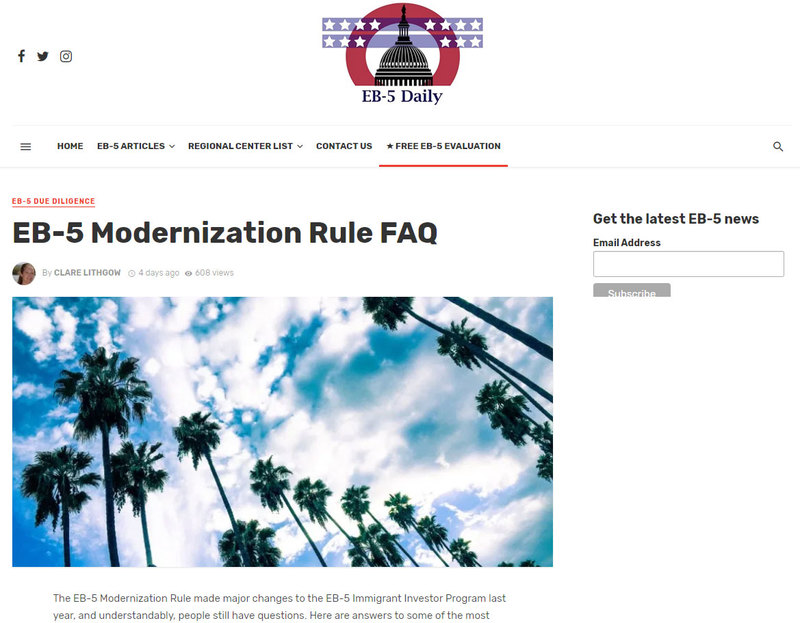The EB-5 Modernization Rule made major changes to the EB-5 Immigrant Investor Program last year, and understandably, people still have questions. Here are answers to some of the most commonly asked questions concerning the main changes that went into effect.
Thanks to the EB-5 Stakeholder Engagement held last week, we now know of EB-5 Modernization Rule Questions and Answers page on USCIS that goes over commonly asked questions since the regulation went into effect.
Below is a quick, easy overview of these EB-5 Modernization Rule frequently asked questions listed on USCIS:
Priority Date Retention Provision
Who may benefit?
Investors who submit new I-526 Petitions on or after Nov. 21, 2019, may in certain cases, use their priority date from a previously approved I-526 Petition. They cannot use an earlier priority date if they’re already in the U.S. under 203(b)(5) or their previous petition was revoke for fraud, willful misrepresentation, or approval was due to a material error.
How do you request an earlier priority date?
Investors may submit a statement to USCIS as part of their new I-526 Petition, requesting an earlier priority date along with a copy of their previous I-526 Petition approval notice. To get a copy of the notice,
Minimum Investment Amounts
What are the new minimum investment amounts and when precisely did they go into effect?
New investments in targeted employment areas: $900,000
New investments in non-targeted employment areas: $1.8 million
These amounts went into effect on November 21,
2019. Investors who filed before November 21, 2019, would be eligible for the previous minimum investment amounts of $500,000 or $1 million, despite their petition being pending on the date of the rule change and despite not having contributed the full investment amount into the new commercial enterprise, as long as they are in the process of actively investing the required amount under the old rule.
Do investors filing new I-526 Petitions, but retaining their old priority date invest the new minimum investment amounts or the old minimum investment amounts?
These investors would need to fulfill the new rule requirements and investment the new minimum investment amounts.
Targeted Employment Area (TEA) Designations
Are investors who filed prior to the date of the rule change impacted by the TEA changes?
No.
What data sources should investors use for establishing high unemployment TEA?
USCIS lists the Census Bureau through the American Community Survey (ACS) and the Department of Labor–Bureau of Labor Statistics (BLS) as verifiable sources for evidence. Whichever source of data the applicant uses, USCIS wants consistent data.
What specific evidence could an investors submit to prove that the new commercial enterprise is located in a TEA under the new rules?
Directly from USCIS:
-
- The location where the new commercial enterprise (or job creating entity, if applicable) is principally doing business
- A map identifying the census tracts included in the proposed TEA (including only the tract(s) where the relevant entity is principally doing business and any or all of the directly adjacent tracts)
- The underlying calculations for establishing the weighted average of the unemployment rate for the specified area
- The reliable and verifiable data that serves as the source of the unemployment statistics for the proposed TEA
- Evidence that the data used is reliable and verifiable (that is, petitioners must show that they used reliable and verifiable methods to obtain their unemployment statistics)
Can a state TEA certification from an I-526 Petition that was approved before November 21, 2019, be used for a separate I-526 Petition filed after Nov. 21, 2019?
No. I-526 Petitions filed after the new rule went into effect are subject to the new TEA rules.
Removal of Conditions on Permanent Residence
Do investor’s derivatives (spouse and children) have to file their own separate I-829 Petitions?
Yes, each derivative files their own I-829 Petition, unless the EB-5 investor is deceased, in which case, they would file together. Derivatives can still also request addition to a pending I-829 if they pay the fee. Children who married and or reached the age of 21 during conditional permanent residency as well as a former spouse who divorced from the principal investor during conditional permanent residency period may still be included on the I-829.
https://www.eb5daily.com/2020/03/eb-5-modernization-rule-faq/
Mentions
States
- New York
Securities Disclaimer
This website is for informational purposes only and does not constitute an offer or solicitation to sell shares or securities. Any such offer or solicitation will be made only by means of an investment's confidential Offering Memorandum and in accordance with the terms of all applicable securities and other laws. This website does not constitute or form part of, and should not be construed as, any offer for sale or subscription of, or any invitation to offer to buy or subscribe for, any securities, nor should it or any part of it form the basis of, or be relied on in any connection with, any contract or commitment whatsoever. EB5Projects.com LLC and its affiliates expressly disclaim any and all responsibility for any direct or consequential loss or damage of any kind whatsoever arising directly or indirectly from: (i) reliance on any information contained in the website, (ii) any error, omission or inaccuracy in any such information or (iii) any action resulting therefrom.




